
Visakhapatnam is the largest and most populous metropolitan city in the Indian state of Andhra Pradesh. It is between the Eastern Ghats and the coast of the Bay of Bengal. It is the second largest city on the east coast of India after Chennai, and the fourth largest in South India. It is one of the four smart cities of Andhra Pradesh selected under the Smart Cities Mission and is the headquarters of Visakhapatnam district. With an estimated output of $43.5 billion, it is the ninth largest contributor to India's gross domestic product as of 2016.

The National Museum in New Delhi, also known as the National Museum of India, is one of the largest museums in India. Established in 1949, it holds a variety of articles ranging from the pre-historic era to modern works of art. It functions under the Ministry of Culture, Government of India. The museum is situated on Janpath. The blueprint of the National Museum had been prepared by the Gwyer Committee set up by the Government of India in 1946. The museum has around 200,000 works of art, mostly Indian, but some of foreign origin, covering over 5,000 years.

The National Museum of Indonesia is an archeological, historical, ethnological, and geographical museum located in Jalan Medan Merdeka Barat, Central Jakarta, right on the west side of Merdeka Square. Popularly known as the Elephant Museum after the elephant statue in its forecourt, its broad collections cover all of Indonesia's territory and almost all of its history. The museum has endeavoured to preserve Indonesia's heritage for two centuries.

The Department of the Middle East, numbering some 330,000 works, forms a significant part of the collections of the British Museum, and the world's largest collection of Mesopotamian antiquities outside Iraq. The collections represent the civilisations of the ancient Near East and its adjacent areas.

Sarnath Museum is the oldest site museum of the Archaeological Survey of India. It houses the findings and excavations at the archaeological site of Sarnath, by the Archaeological Survey of India. Sarnath is located near Varanasi, in the state of Uttar Pradesh. The museum has 6,832 sculptures and artefacts.
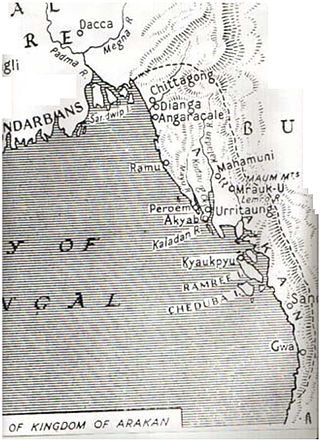
Rakhine State occupies the northern coastline of Myanmar up to the border with Bangladesh and corresponds to the historical Kingdom of Arakan. The history of Rakhine is divided into 7 parts - the independent kingdoms of Dhanyawadi, Waithali, Lemro, Mrauk U, Burmese occupation from 1785 to 1826, British rule from 1826 to 1948 and as a part of independent Burma from 1948.

Thotlakonda Buddhist Complex is situated on a hill near Bheemunipatnam about 15 kilometres (9.3 mi) from Visakhapatnam in Andhra Pradesh, India. The hill is about 128 metres (420 ft) above sea level and overlooks the sea. The Telugu name Toṭlakoṇḍa derived from the presence of a number of rock-cut cisterns hewn into the bedrock of the hillock. In 2019, the stupa was partially damaged due to monsoons, but it was restored by 2021 at the cost of Rs 42 lakh.
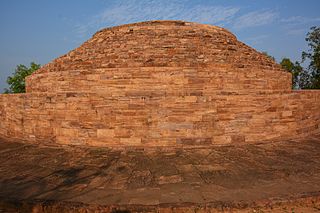
Lalitagiri is a major Buddhist complex in the Indian state of Odisha. The complex is home to stupas, 'esoteric' Buddha images, and monasteries (viharas), which is the oldest site in the region. Significant finds at this complex include Buddha's relics. Tantric Buddhism was practiced at this site.
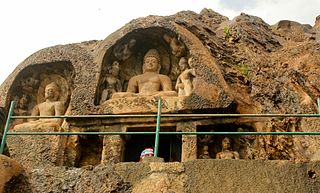
Bojjannakonda and Lingalakonda are two Buddhism rock-cut caves on adjacent hillocks, situated near a village called Sankaram, Anakapalle of ancient Kalinga. in the Indian state of Andhra Pradesh. The sites are believed to date between 4th and 9th Century A.D, when Buddhism is the majority religion of Sankaram. The original name of Bojjannakonda is Buddina Konda.

Bavikonda Buddhist Complex lies about 16 km from Visakhapatnam, in the Indian state of Andhra Pradesh, on a hill about 130 metres above mean sea level. The term Bavikonda in Telugu means a hill of wells. As per its name, Bavikonda is a hill which has wells for the collection of rainwater. Bavikonda Monastic ruins dates back to the 3rd century BCE.
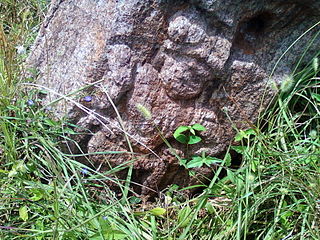
Pavurallakonda or Pavurallabodu is a hill popularly known as Narasimhaswamy Konda. It is located near Bheemunipatnam, about 25 km north of Visakhapatnam, Andhra Pradesh, India.

The Amaravati Collection, sometimes called the Amaravati Marbles, is a series of 120 sculptures and inscriptions in the British Museum from the Amaravati Stupa in Amaravathi, Guntur in the Indian state of Andhra Pradesh. The Amaravati artefacts entered the Museum's collection in the 1880s. The Amaravati sculptures were sometimes also called the Elliot Marbles on account of their association in with Sir Walter Elliot, who had them removed from the site to Madras in the 1840s.

The Buddhapad Hoard or Buddam Hoard is a large cache of Buddhist and Jain sculptures found near the town of Buddam in Andhra Pradesh, southern India. Since 1905, it has formed an important part of the British Museum's South Asian collection. Dating from 6th-8th centuries AD, the style of craftsmanship fuses the northern influences of the Gupta period with the southern traditions of the Deccan, which in turn greatly influenced Buddhist art in South East Asia in subsequent centuries.
The Siyot Caves, sometimes referred to as the Kateshwar Buddhist Caves, are five rock-cut caves located near Siyot village in the Lakpat Taluka of Kutch district, Gujarat, India. The caves are believed to belong to the first century AD.
Alluri Sitarama Raju International Airport is an international airport and a greenfield airport under construction at Bhogapuram in the Vizianagaram district. The airport is operated by GMR Visakhapatnam International Airport Limited. The airport is named after Indian Independence revolutionary and freedom fighter Alluri Sitarama Raju.
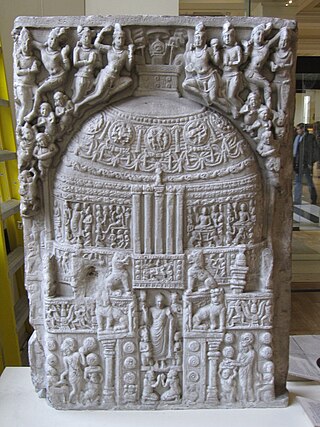
Amarāvati Stupa is a ruined Buddhist stūpa at the village of Amaravathi, Palnadu district, Andhra Pradesh, India, probably built in phases between the third century BCE and about 250 CE. It was enlarged and new sculptures replaced the earlier ones, beginning in about 50 CE. The site is under the protection of the Archaeological Survey of India, and includes the stūpa itself and the Archaeological Museum.

Chandavaram Buddhist site is an ancient Indian Buddhist site in Chandavaram village in Prakasam district in the Indian state of Andhra Pradesh. Situated on the bank of Gundlakamma River, the site is 10 kilometres (6.2 mi) northwest of Donakonda railway station. The Chandavaram Buddhist site was built between the 2nd century BCE and the 2nd century CE during the Satavahana dynasty and was discovered by Veluri Venkata Krishna Sastry in 1964.
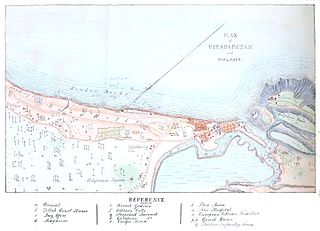
Visakhapatnam is a major metropolitan city in the state of Andhra Pradesh, and it holds the distinction of being the largest city in the state. The rich history of Visakhapatnam dates back over 2,500 years, with its present name potentially given by the Eastern Chalukyas king to their family deity Visakha in 1010 CE. Visakhapatnam was once part of the Kalinga Kingdom around 260 BC before coming under the influence of the Maurya Empire. During this period, Buddhism flourished, leading to the construction of significant monuments between the 2nd century BCE and the 2nd century CE. The city's documented existence begins in 1068 CE, under the rule of King Vishakhavarman. In the 7th century, Visakhapatnam witnessed the conquest of the Eastern Chalukyas, and by the 14th century, it became part of the Reddi Kingdom. The era of European colonization commenced in 1630 with the Dutch, followed by the British taking control in 1757 after a brief interlude of French influence. The Battle of Vizagapatam in 1804 during the Napoleonic Wars emphasized the strategic importance of the city. Following India's independence in 1947, Visakhapatnam became part of the Madras Presidency, later becoming an integral part of Andhra Pradesh. Today, it stands as the largest city in Andhra Pradesh, playing a pivotal role in the state's economy. The city's industrial growth saw a transformative phase with the inauguration of Visakhapatnam Port operations on December 19, 1933, firmly establishing it as a major industrial centre.

The Buddha Preaching his First Sermon is a stone sculpture of the 5th-century CE showing Gautama Buddha in the "teaching posture" or dharmachakra pravartana mudrā. The relief is 5' 3" tall, and was excavated at Sarnath, India by F. O. Oertel during the 1904–1905 excavation season of the Archaeological Survey of India (ASI); it was found in an area to the south of the Dhamek Stupa.
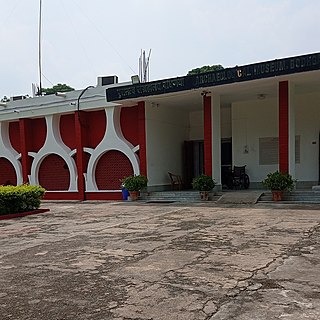
Archaeological Museum of Bodhgaya is a museum of archaeology in Bodhgaya, Bihar, India, located in close proximity to the Mahabodhi Temple complex. Established by the Archaeological Survey of India in 1956, it features several sculptures, artifacts and antiquities pertaining to Buddhism and Hinduism from 2nd century BC to 11th century CE, including some objects and coins from Mauryan, Gupta and Mughal periods.





















